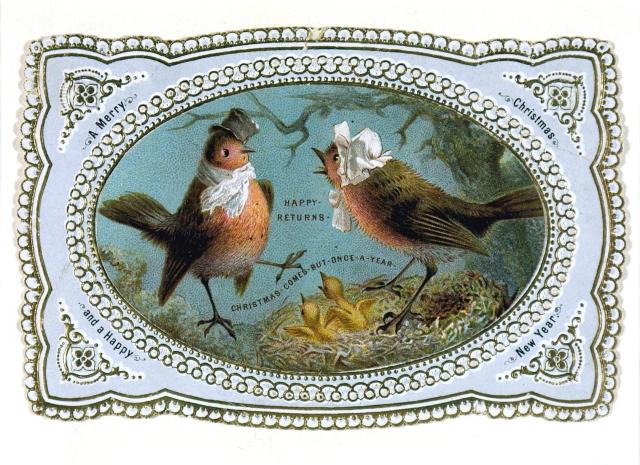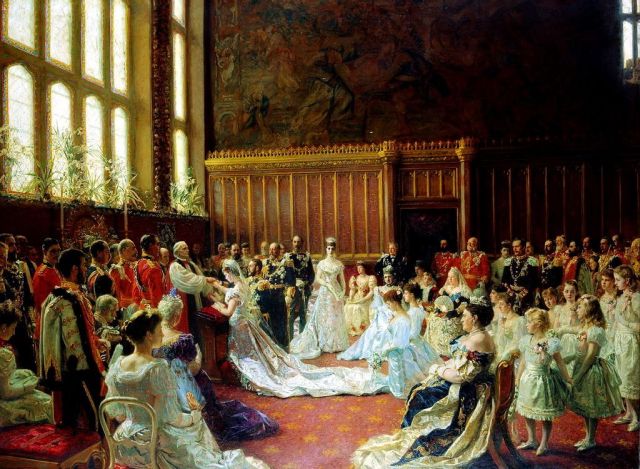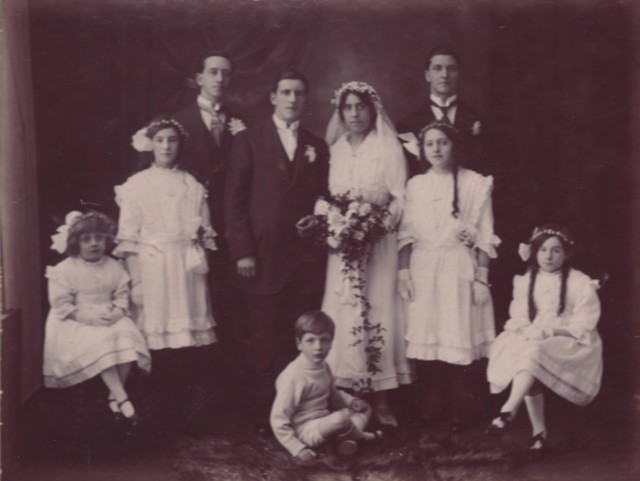
It was a coster wedding, at which, by lucky chance, I once happened to be present. … It was difficult at first to distinguish which were the bride and bridegroom-elect; but there was one lad, the splendour of whose tie and the redundance of whose buttons proclaimed him to be the happy man; and on his arm there leaned a maid whose face shone with soap and happiness, and the feathers of whose hat stood out several inches further over its brim than those on the headgear of her companions, and therefore marked her as the bride.
“A Costermonger’s Wedding,” Every Woman’s Encyclopaedia, 1912
During the years of researching our Victorian-era family for The Cowkeeper’s Wish, we came upon a number of marriages that took place on Christmas Day and Boxing Day. Working class people typically worked six days a week in those times, and these were two days that they and their relatives could probably count on having to themselves. On top of that, churches often offered their services free or at reduced rates on Christmas, and a flip through marriage registers shows a definite spike in the number of ceremonies performed.

Our great grandmother’s sister, Jennie Evans, married her shoemaker love Richard Vanson on December 25, 1890, at St. Saviour’s Church in Southwark. Nowadays St. Saviour’s is the beautiful Southwark Cathedral, but at the time of Jennie’s wedding, it was in the midst of a long overdue renovation that would transform it from “as vile a preaching-place as ever disgraced the 19th century” into a glorious place of worship.
The ongoing work made the normally large church tiny, and the only place in use at the time of Jennie and Richard’s wedding was the ancient and intimate Lady Chapel, a portion of St. Saviour’s that had not been spoiled in earlier renovations. Jennie’s sister (our great grandmother) and her brother-in-law signed as witnesses to their union.
The minister was busier than usual that day. The register shows 13 couples were joined in holy matrimony on the 25th, more than double the amount that took place in all of December. The grooms list jobs like lighterman, brush maker, and varnish maker, and hail from addresses close to Jennie and Richard’s on Red Cross Street, so they were no doubt poor, and happy to reap the benefits of marrying on Christmas Day.
The tradition had begun years earlier, and continued for decades, though it’s a challenge to find out what such weddings were really like, since the people who wrote about the working class — however fine their intentions — were often not of that class themselves, but rather outsiders looking in. In 1866 the writer and social explorer James Greenwood described “penny wedders” arriving at a London church, and wrote of a guest: “[his] attire was not at all of a bridal character, and consisted of greasy fustian, and a dirty cotton neckerchief wisped about the collar of his blue-checked shirt. His face was dirty, too, as were his hands — a fault he seemingly was not unconscious of, as from time to time he gave them a sly rub on his coat-tail.”
As more couples poured in to the church to be married, writes Greenwood, “sight-seers flocked in to see the fun. The candidates for matrimony were nearly all of the very lowest order, and the marrying couples were, as a rule, very young. There were exceptions however. In one case an old man, at least sixty, had brought to the altar an old woman as old as himself, and who wore on her marriage finger as many plain rings as should and doubtless would have been a caution to the old gentleman had they each represented a previous espousal; but they did not. A fancy for wearing plain rings prevails amongst many barrow-women, and they prefer them to stone rings. There was another instance of middle-aged folks coming together, and one that was rendered remarkable from the fact of the parents bringing with them a troop of illegitimate children—the eldest a lanky boy of fifteen—to see them ‘made honest.’ I gathered this fact from the buzzing and whispering about me, and it was curious to note the variety of opinion that prevailed on the subject. Some said it was a good thing, and ‘better late than never.’ Others, that it was a bad thing, and a pity that some people must make ‘poppy shows of theirselves.'”
Christmas weddings certainly happened because people were poor and had little time away from their jobs. An 1865 article notes that a Lambeth clergyman had to commence his marriage ceremonies at 8 a.m. that Christmas in order to get through them all. And in 1899 in the East End, some 84 ceremonies were performed at one church. “They were mostly the costermonger class,” the article notes. “They were accompanied by large numbers of their friends, and crowds of people assembled outside the building and saluted each departing couple with showers of rice and confetti. The proceedings were enlivened with selections from mouth-organs.” There are stories of couples being married five at a time, and even a dozen at a time, “and it is satisfactory to know that the various husbands and wives paired off happily, without any ill results of this great ‘mix.'”
Sadly, there are few proper wedding portraits in our family archive from this period, and an online search for Victorian weddings more commonly turns up images of privileged people. At one extreme end of the spectrum, Prince George and Mary of Teck married just a few years after Jennie and Richard, and the opulent setting is depicted in this Laurits Tuxen painting, where light streams through the chapel windows at St. James Palace, and the jewels and taffeta shine.

Bargain Christmas weddings continued well into the 20th century, and really only began to die out as working conditions improved. The practice was still in place during WW1, when our ancestor Clara Donnelly married a munitions worker named Bert Morel. Listed alongside them in the register that day and the next are other munitions workers and soldiers marrying their brides, and perhaps adding “Happy Christmas” after the “I do.”

♥
Sources
“84 Couples Married at One Church.” Coventry Evening Telegraph, 26 December, 1899.
“Christmas Marriage in Birmingham.” Leicester Chronicle, 3 January, 1891.
“Christmas Marriages at St. Mary’s.” South London Press, 30 December, 1865.
“At a Penny Wedding.” Shields Daily News, 25 September, 1866.
The History of the Collegiate Church of St. Saviour. Rev. W. Thompson, 1894.
The Marriage of George, Duke of York, with Princess Mary of Teck, July 1893. By Laurits Regner Tuxen, Royal Collection Trust.
“A Costermonger’s Wedding.” Every Woman’s Encyclopaedia, 1912.

It seems so romantic to get married on Christmas Day but when you work the other 6 days of the week, it must have quite a scramble to get things ready, and celebrate Christmas too. But then, having Christmas dinner and a wedding dinner combined would also be very nice.
LikeLiked by 1 person
What an interesting story about multiple weddings at once. And there is something kind of nice about each couple celebrating with the others. The more the merrier they say. And what a passage from Every Woman’s Encyclopaedia Simply darling!
LikeLiked by 1 person
Thank you!
LikeLike
Pingback: Part 5: Ellen Shelley, George Smith and the Great War – The Cowkeeper's Wish
Dear Kirsten and Tracy,
Thank you so much for providing this information. My great-great grandfather was married on Christmas Eve, 1865 at St. Mary’s, Lambeth. I have always been surprised to find how many other ceremonies there had been in the church on the same day and now, of course, it all makes sense.
One problem that I have not been able to solve is that his father’s name is incorrectly recorded on the marriage record (James, rather than Joseph). The fact that so many records would have been written, likely in a bit of a hurry, at least makes it plausible that a mistake went unnoticed that day.
I would love to read the original article that you cite: “Christmas Marriages at St. Mary’s.” South London Press, 30 December, 1865, but have been unable to track it down. I would be really grateful if you could let me know where you found it so I can get hold of a copy.
Thanks for any help you are able to give – and again, for helping me make sense of this tiny snippet of my family history.
Very best wishes
Paula
LikeLiked by 1 person
Hi Paula. Thanks for getting in touch. I found the article at the British Newspaper Archive, https://www.britishnewspaperarchive.co.uk/. Unfortunately there are no specific mentions of brides or grooms, but I’ll transcribe it here: “Christmas Marriages at St. Mary’s.— A most extraordinary number of marriages took place at Lambeth Old Church on Christmas morning last. The number amounted to 40, and, in consequence, the officiating clergyman was obliged to commence his labours as early as eight o’clock in the morning, in order that he might have the whole concluded before the time arrived for the solemnisation of divine service. The reason of this influx was that on that day there is a reduction of 3s., 6d. or 4s. below the sum charged for fees by the district churches. On Boxing Day, the marriages exceeded the average, there being 14 happy couples united in holy wedlock.” I hope that’s helpful, and wish you good luck with your mystery!
Kristen
LikeLike
Fascinating! I never knew why so many of my ancestors married on Christmas Day.
LikeLiked by 1 person
My late uncle Charles Saunders married Joan Peppercorn on Christmas Day, 1946, probably at Basildon, Essex.. He was a naval rating. In celebration he always provided a bottle of champagne for our Christmas dinner in later years, which was very welcome.
LikeLiked by 1 person
Lovely!
LikeLike